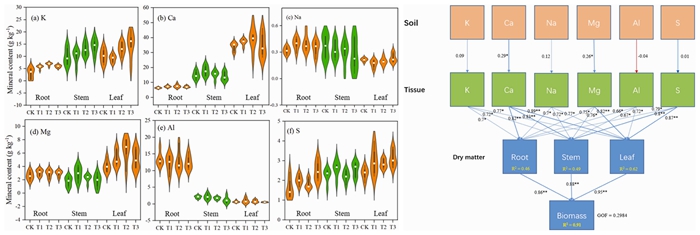New progress in research on the response of tobacco mineral composition and absorption to the application of potassium sulfate fertilizer
Recently, the research center for Cultivation and Nutrition of the Institute of Tobacco Research (TRI), Chinese Academy of Agricultural Sciences has made new progress in the response of tobacco mineral composition and absorption to the application of potassium sulfate fertilizer. The results were published in Industrial Crops and Products .
Soil and tobacco mineral compositions undergo diverse and complex reactions to the application of potassium sulfate fertilizer, the primary fertilizer utilized in Chinese tobacco cultivation. To investigate these reactions, we conducted an 8-year field experiment in Shandong province, a major tobacco production region in China. Different levels of potassium sulfate were applied, including non-fertilized CK, low T1 (compound fertilizer of potassium sulfate with 15%N, 15%P2O5, 15%K2O, and 12%S on a weight of 550 kg ha-1), medium T2 (potassium sulfate fertilizer with 50% K2O and 18% S on a weight of 165 kg ha-1 added to the T1), and excessive T3 treatments (potassium sulfate fertilizer with 50% K2O and 18% S on a weight of 330 kg ha-1 added to the T1). The study measured soil exchangeable minerals and tissue total minerals in root, stem, and leaf, encompassing potassium (K), calcium (Ca), sodium (Na), magnesium (Mg), aluminum (Al), and sulfate (S). The findings indicated significant increases in soil exchangeable K and available S contents in T2 and T3, with T3 exhibiting the highest increments (274% and 616% compared to CK). Tissue K and S content showed significant increases in T1, T2, and T3, particularly in roots. Conversely, tissue Ca and Mg exhibited an increasing trend similar in T1 and T2 but decrease in T3, especially in stems and leaves. Tissue Na increased in roots of 22% but decreased in stems of -17% and leaves of -0.05% when collectively considering T1, T2, and T3. Notably, tissue Al content remained unaltered by potassium sulfate application. Correlation analysis revealed that tissue K and S increased rapidly with soil exchangeable K and available S at low levels but slowed down as soil mineral contents rise. Tissue Ca, Na, and Mg initially increased with corresponding soil contents but decreased when soil content reaches extreme levels. Tissue Al, however, showed a significant decrease with soil exchangeable Al. Tobacco biomass significantly increased in T1 and T2 and displayed improvement, though not statistically significant, in T3 compared to CK. Path analysis identified soil Ca and Mg as pivotal factors influencing tobacco dry matter accumulation through tissue mineral compositions. In conclusion, the application of potassium sulfate fertilizer significantly impacted soil and tobacco mineral compositions, with distinct effects observed in various tissues, ultimately influencing tobacco biomass accumulation.
The first author of the paper is a PhD student Fahui Jiang from Jiangxi Agricultural University. Xiao Xin, a master's student from TRI, is the co-first authors. Professor Jianxin Dong, Associate Professor Ping Cong from TRI are co-corresponding authors of the paper. This research was supported by funding from the Central Public interest Scientific Institution Basal Research Fund (1610232023011).
The article link is : https://doi.org/10.1016/j.indcrop.2024.118155

By Cong Ping (congping@caas.cn)
-
 Apr 18, 2024Opening Ceremony of the Training Workshop on Wheat Head Scab Resistance Breeding and Pest Control in Africa Held in CAAS
Apr 18, 2024Opening Ceremony of the Training Workshop on Wheat Head Scab Resistance Breeding and Pest Control in Africa Held in CAAS -
 Apr 03, 2024IPPCAAS Co-organized the Training Workshop on Management and Application of Biopesticides in Nepal
Apr 03, 2024IPPCAAS Co-organized the Training Workshop on Management and Application of Biopesticides in Nepal -
 Mar 28, 2024Delegation from the School of Agriculture and Food Science of University College Dublin, Ireland Visit to IAS, CAAS
Mar 28, 2024Delegation from the School of Agriculture and Food Science of University College Dublin, Ireland Visit to IAS, CAAS -
 Mar 25, 2024Director of World Food Prize Foundation visited GSCAAS
Mar 25, 2024Director of World Food Prize Foundation visited GSCAAS -
 Mar 20, 2024Institute of Crop Sciences (ICS) and Syngenta Group Global Seeds Advance Collaborative Research in the Seed Industry
Mar 20, 2024Institute of Crop Sciences (ICS) and Syngenta Group Global Seeds Advance Collaborative Research in the Seed Industry
